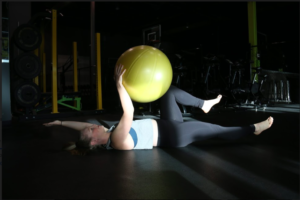
Hate is a strong word, but fully appropriate for my thoughts on this exercise!
Your Time Is Precious
The crunch is one of the most useless exercises you can do in the gym, especially if you are an athlete. As most endurance athletes can relate, there never seems to be enough time to get in all the scheduled training, sleeping, cooking/ healthy eating, social time with family and friends while ALSO making a living. Usually this means that something gets cut – and there are often consequences. Skip work? That money is needed to pay for races. Skip sleep? Our immune system will be compromised and the quality of our workouts decreases. Eat take-out food? Unwanted weight gain (despite our high training loads) is likely expected. So what can you skip? The garbage “strength” exercises that are doing NOTHING for your performance.
Performance Strength Training
The main difference between performance strength training and personal training is the goal of the program. Performance strength training refers to working with athletes (recreational/ amateur/ pro) who are training for a specific sport. Personal training generally refers to non-sport specific training goals. For athletes, each exercise should directly or indirectly increase the performance or decrease the chance of injury. Knowing that each exercise in the program of an athlete needs to be specific and executed with a purpose we must ask the question, “what is the purpose of a crunch”?
Core Strength
Perhaps the purpose of the crunch is to increase core strength. We know core strength is crucial for performance because it gives our arms and legs a stable base to produce power. However our core includes all the muscles from our shoulders to our hips – not just our abdominal muscles. Unfortunately only training one part of your core is quite un-functional. If there are weaknesses in ANY part of your core, your ability to generate power is going to be decreased. Therefore performing a crunch isn’t likely going to do much for strength in the sense of training your core as a whole.
Best Bang-For-Your-Buck
In terms of time management – is it more beneficial to use 5 different exercises to get each section of your core (from hips to shoulders) or pick 2 or 3 exercises that train your entire core at the same time? Further, exercises that train all parts of your core simultaneously means that with 3 different exercises, each section of your core is trained 3 times. In comparison, 3 different isolated exercises means each section only gets trained once. In terms of muscle physiology, it is well known that superior strength gains are achieved when a muscle is worked multiple times as opposed to once for a longer duration. If your goal is core strength, a crunch is far from a good choice.
Decreases in Abdominal Fat
Perhaps your purpose for doing a crunch is to decrease body fat? Interestingly the effectiveness of abdominal exercises on reducing abdominal fat was tested in 2011. 7 ab-based exercises (bent-knee sit-up, lateral trunk flexion, leg lifts, oblique crunch, stability ball crunch, stability ball twist and abdominal crunch) were chosen for the following protocol: 2 x 10 repetitions, 5 days/ week for 6 weeks. At the end of the 6 weeks, researchers concluded NO decreases in abdominal fat compared to the control group. This was concluded by the use of a DXA (the gold standard for assessing body composition to date), waist circumference and abdominal skin fold.
Conclusions
In conclusion, there is no benefit for an athlete to perform crunches in order to improve sport performance. However, there are significant benefits to including core exercises that engage your entire core in a dynamic way. For example, dead bugs, walking planks or renegade rows are all great examples of exercises that are performed with a neutral spine while your arms and legs are in motion.
Read more key tips around designing your optimal strength program
Amanda Regnier
MSc. Strength and Conditioning, C.S.C.S
Functional Range Conditioning Specialist
Runner/ Triathlete